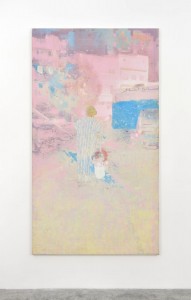ART CITIES:Brussels-Alexandre Lenoir
 After graduating from Ecole des Beaux-Arts de Paris with honors in 2016, Alexandre Lenoir moved to Casablanca in 2017 for a residency, where he practiced painting. Having encountered this medium before his studies at the Beaux-Arts, he worked on large-scale figurative works, which are systematically created in different territories, over a period that varies from a few days to seven months. Assuming the form of incarnation, everything becomes brushwork, and the presentation also has its significance.
After graduating from Ecole des Beaux-Arts de Paris with honors in 2016, Alexandre Lenoir moved to Casablanca in 2017 for a residency, where he practiced painting. Having encountered this medium before his studies at the Beaux-Arts, he worked on large-scale figurative works, which are systematically created in different territories, over a period that varies from a few days to seven months. Assuming the form of incarnation, everything becomes brushwork, and the presentation also has its significance.
By Efi Michalarou
Photo: Almine Rech Gallery Archive

Alexandre Lenoir expresses himself exclusively through the medium of painting, which he uses to oscillate between realism and texture effects. He explores the visual relationship with his canvas head-on, but also views it as a conceptual tool, often questioning the legitimacy of his endeavour. Lenoir presents his solo exhibition “On the Edge” at Almine Rech Gallery In Brussels. Lenoir’s canvases can take several months to come into existence, as he is always keen to fine-tune the effect, although some sections of the work may only have taken him a couple of days. His subjects are chosen at random; he fishes out an image from his personal photographic archive and projects it on the wall. “I’m not trying to achieve a realistic rendering”, he explains. “In fact, I work in the dark, with masking materials. I use masking tape, layer paint washes, and when I remove the tape, I discover my work. The process is reminiscent of photography: there is latency in the image, it emerges gradually”. The artist’s vocabulary makes references to revelation, chance and acceptance of what the canvas can produce almost of its own accord. Here, Lenoir’s life experiences and intimate moments are not necessarily identifiable; what they can do is trigger the beholder’s own personal memories, and the artist enjoys the diversity of interpretations. You can identify landscapes, often lush; disparate assemblages, bodies, hypnotic presences, but also interiors. When focusing on his canvas, almost meditatively, he raises questions of balance and opposition. The paint wash’s liquidity contrasts with the accumulation of layers; the glossy with the dull; the bright colors with the browns, ochres and blacks; a narrative effect with a simple abstract composition… Taken as a whole, his work talks of memories, personal and collective: it unearths the remains of a past that may not have existed at all. To him, what is crucial is that the elements should collide to form a body of work which he readily describes as silent, or ‘monk’. The rules and framework he imposes upon himself are the starting point of his work’s autonomy: he retains control but lets it live its own life. He accepts the randomness, while finding his place between technique and what must appear. In other words, he influences a form of process in the making to construct a painting. Countless hours spent in the studio are his reason to try to describe “the painting, this extremely ambiguous object which belongs to multiple realities” and accept that the eye is indeed what brings a painting into existence. Starting with his own, as his only light source when painting is the projector; his canvas only becomes discernible to him once he has finished making it. Beyond the image, the painting propels us into its heart and materiality while also encouraging us to view a representation, thus intellectualised by our brain.
Info: Almine Rech Gallery, Abdijstraat 20 Rue de l’Abbaye, Brussels, Duration: 15/10-19/12/20, Days & Hours: Tue-Sat 10:00-19:00, www.alminerech.com


Right: Alexandre Lenoir, La sourse, 2019, Acrylic and oil on cotton canvas, 204 x 142 cm, Courtesy the artist and Almine Rech, © Alexandre Lenoir, Photo: Antoine Rozès
